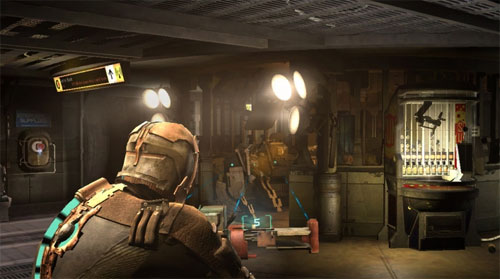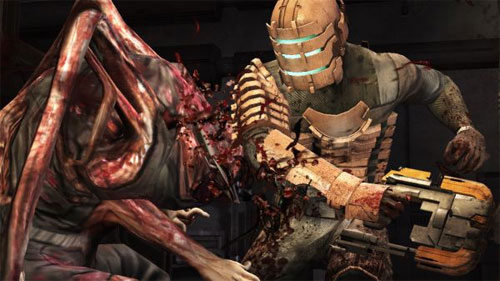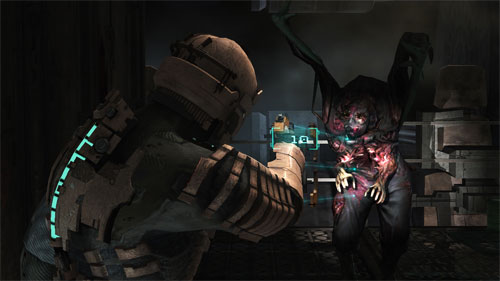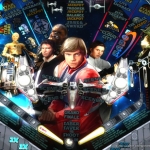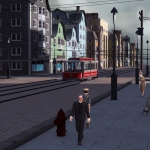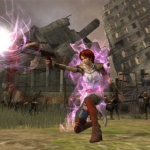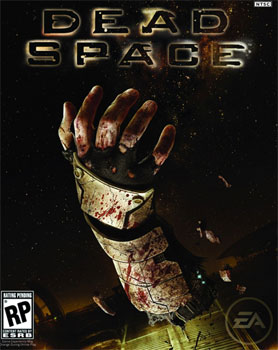
Over the past week I’ve been making my way steadily through the labyrinthine hallways of the Ishimura, trying to survive hordes of grotesquely mutated creatures. After emerging at the other end of the journey, I can safely say that Dead Space is the cream of the horror video game crop.
Developed by EA Redwood Shores, Dead Space drops you into the role of space engineer Isaac Clarke. The tale begins as Isaac is being shuttled to the USG Ishimura, an enormous mining spacecraft that has issued a distress call and then stopped communicating. Thinking that the ship’s comm arrays are all that need fixing, the Concordance Extraction Corporation (CEC) sends Isaac, along with a small security detail, to repair the ship. Things don’t go quite that smoothly, of course, as the gameplay begins shortly after your shuttle craft has crashed into the landing bay of thr Ishimura. Very shortly, Isaac’s team is beset by horrifying creatures that come to be known as Necromorphs, and Isaac begins his quest to figure out what’s going on in this deathtrap of a ship.
The survival horror gaming genre has come a long ways, and Dead Space is the next step in its evolution. Retaining a lot of elements from previous installments in the genre, such as the Resident Evil 4 over-the-shoulder third person viewpoint, Dead Space deviates from previous efforts by moving into the science fiction realm with a lot of innovations and clever gameplay decisions. The first and most obvious point of originality is in the creatures infecting the Ishimura and how Isaac must deal with them.
A lot of survival horror games expect the player to run from the baddies instead of fighting them, but Dead Space is a game that wants you to get your hands dirty. The Necromorphs come in many varieties, but there’s one common way to kill all of them: dismemberment. Indeed, “strategic dismemberment” is the term the design team used to describe the combat from early in the game’s development. The enemies’ bodies will react in different ways, depending on how and where Isaac attacks them. If he severs the creature’s legs, it will fall to the ground and try to drag itself along with its arms. If the arms are gone, it still will run but will have to resort to biting or ramming for attacks. Typically, removing the arms and the legs will kill the monsters. And don’t even think about getting any quick headshot kills here. Removing Necromorphs’ heads tends to send them into crazed frenzy attacks.
With all this dismembering going on, it’s no surprise that Dead Space is replete with blood and gore. From the basic monster designs to the environments to the combat effects, viscera is present and plentiful. The dead monsters’ bodies (and parts) remain behind after Isaac is finished with them, so there will be occasions when he literally wades through piles of monster flesh. It wasn’t unusual in my playtime for me to hear a shuffling sound as I wandered down a corridor, only to realize that some stringy and disgusting severed Necromorph appendage had wrapped around Isaac’s leg and was being dragged along with him.
If you’re going to be doing lots of cutting and chopping, you’ll need some good tools for the job, and Dead Space delivers in the most original of ways. As the game is set on a working mining ship that suddenly is overrun, the crew of the ship left things pretty much in medias res. The weapons you’ll find all are tools that were left behind as the crew ran for their lives. Being an engineer, Isaac is able to adapt repair devices and tools into vicious blasters and cutting torches. The first weapon you find will be a plasma cutter, and your arsenal will expand with the likes of a force cannon, an adapted flamethrower, and more. Isaac also has a telekinetic unit in his suit, intended for helping move around large pieces of cargo. In the course of the game, Isaac retasks it to act as a sort of Star Wars-y Force grab and throw. My personal favorite among the weapons is the ripper, which consists of a circular saw blade spinning in midair before Isaac and controlled by his telekinesis.
As you proceed through the game, you’ll have many opportunities to upgrade and enhance Isaac’s gear, from his basic engineering suit to each of his weapons to the telekinetic unit to his statis unit (a device that slows time for individual elements of the environment or individual enemies). Upgrading Isaac’s tech usually involves interfacing with work benches scattered throughout the Ishimura and using power nodes to connect circuits that power things up. Once you finish the game, you’ll be able to start all over again with his gear already powered up to the point where you left it at the end of the previous game, allowing you to enchance everything even more the next time through. This is a very convenient way of nabbing achievements or trophies, depending on which platform you’re playing.
Another unique gameplay element that runs throughout Dead Space is zero gravity navigation and combat. There are many parts of the ship that either have no gravity by design or have been damaged to the point of losing gravity. Isaac is forced to work in this zero-G space, which often involves performing long range jumps from the floor to the ceiling to the wall and back again. There’s a neat level of puzzle solving inherent with these zero-G scenarios, and it never really feels “gamey” in the least. Everything flows together in logical ways, even when you lose oxygen in addition to gravity and have to keep an eye on your suit’s O2 supply so that you don’t suffocate.
Dead Space is a game without a traditional status bar or HUD. Everything you see on the screen is exactly as it would appear on the Ishimura, without the hindrance of a health meter or minimap. Isaac’s engineering suit (or “rig”) has a row of lights on the back that monitors his level of injury, and his suit features a projector that displays any pertinent information before his face, as if he were watching it through his visor. It’s all very unique and helps keep you in the game at all times, instead of jumping you out to paused menus.
Even with all the gameplay developments and innovations, Dead Space would be nothing without a suitably engaging plot and creepy atmosphere. This is where the game really delivers. The story deepens as Isaac proceeds through the ship, and it grabbed me more and more, making me really want to finish and find out what really was going on and how it all would play out. The atmosphere is undeniably creepy, and not just in a Silent Hill everything-is-rusty way. The art design, coupled with the ambient noise, is real and subtle enough to make you constantly wary. It did a very good job of creeping me out, and many times the level design diverted my attention in one direction to set up a really good scare coming from somewhere completely unexpected.
The only thing that detracted at all from my enjoyment of Dead Space was an incredibly frustrating asteroid-shooting minigame that pops up midway through the game. It feels very tacked-on and not at all in sync with the rest of the game. As if the jarring insertion of the minigame were not bad enough, it’s a required part of the game that you have to complete in order to proceed with the main story. It took me a couple of nearly thrown controller instances before I finally got through this part of the game. So, while I give an undeniably enthusiastic thumbs up to the majority of Dead Space, I have to give a huge thumbs down to this bit of the experience.
There are a ton of new video games hitting the market right now, so it’s easy to lose Dead Space in the deluge. Don’t overlook this amazing game, though. In between your marathon sessions of Fable II and Fallout 3, you really owe it to yourself to delve into the bowels of the USG Ishimura for some genuinely scary and innovative fun.


